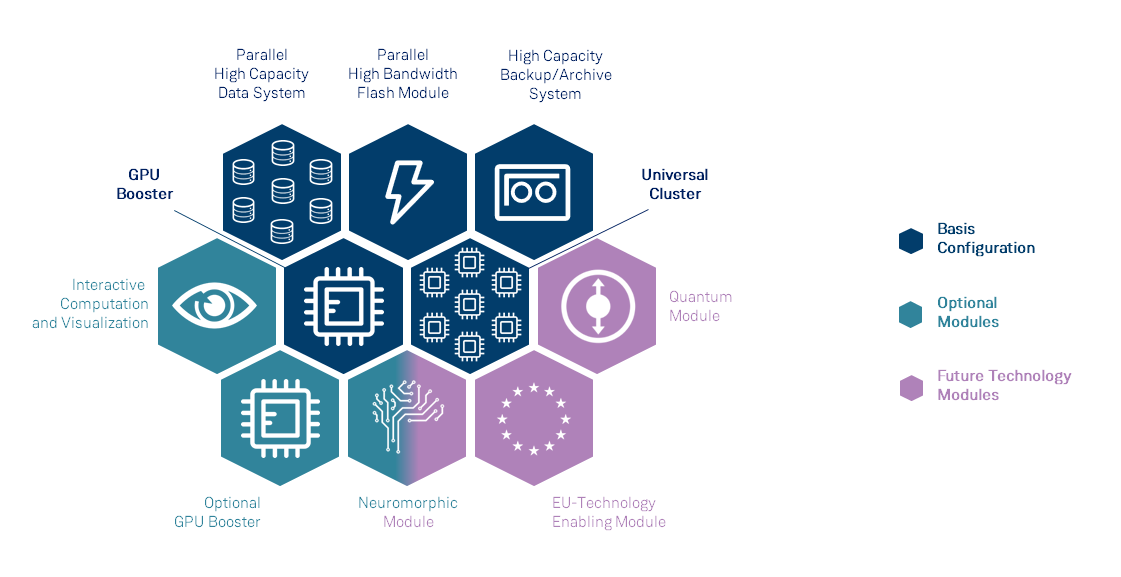Europe's First Exascale Supercomputer to Unlock a Quintillion Ops
Onwards to JUPITER, with feet firmly planted in the old continent - for now.
Europe's push towards HPC (High-Performance Computing) relevancy is an ongoing effort laid out in the European Union's (EU) EuroHPC Joint Unit initiative. As part of this program, the old continent has already deployed its first pre-exascale system, LUMI, which integrates the latest technology from AMD in a quantum-ready system that also boasts an awe-inspiring carbon-negative design. But LUMI is a stepping stone towards the real goal: post-exascale computing. As covered by Computerbase, that honor is for the stratospheric-defiant JUPITER (Joint Undertaking Pioneer for Innovative and Transformative Exascale Research) supercomputer.
JUPITER will be installed in Jülich's Supercomputing Centre in Germany, with the EU setting aside a whopping €500 million (~$522 million) for infrastructure, hardware, and installation costs alone. The system, expected to be operational sometime beyond the 2024 timeframe, will be the continent's first to surpass the trillion operations per second threshold.
Unlike LUMI, JUPITER will be leveraged towards the fields of climate modeling, materials engineering, biological simulations, and sustainable energy production research while leveraging the latest AI acceleration. Unfortunately, these are all computed and memory-demanding workloads, which justify the installation's high price.
There hasn't been any official confirmation regarding what hardware will power JUPITER. Still, the press release - and the current state of HPC environments - place significant responsibility on the feet of GPU-based accelerators. JUPITER will seemingly take lessons from LUMI's star-based architecture, with different supercomputing modules being brought to bear in GPU visualization, alongside a universal, CPU-based accelerator cluster, a high-performance GPU cluster; a quantum computing node as well as hot and cold storage clusters. In addition, JUPITER will dive one step further toward more exotic computational models than LUMI in that it will include a node fully dedicated to neuromorphic computing.

The similarities to LUMI might imply that AMD will again benefit from this massive contract - and we'd say there are good reasons for that, particularly regarding power efficiency. But Intel isn't happy with being left in the rearview mirror regarding supercomputing installations, which now counts an impressively split of five out of the world's ten fastest supercomputers and ten out of twenty utilize AMD's hardware.
Another chip in Intel's hat of tricks could be any leverage gained via its announcement of its Silicon Junction initiative. The blue giant is pouring an estimated $80 billion into semiconductor manufacturing and R&D capabilities across the EU and serves as a concession to the EU's attempted plan at semiconductor independence. Without official confirmation, this remains speculation, so take this with an adequate amount of NaCl.
One of the most impressive elements regarding JUPITER's announcement is its power consumption. While the world's top supercomputer, Frontier, reaches an average of 19 MW in power consumption, JUPITER is claimed to average out at just 15 MW - cutting 22% in power requirements within a couple of years of hardware development. And it's an almost 50% power consumption reduction compared to the former world champion in the supercomputing field, Japan's Arm-based Fugaku. Installed in 2020, its average power consumption is around 29 MW while offering "only" 537.21 PFlop/s in peak performance - half that of JUPITER. That's equivalent to a doubling in power efficiency in half a decade - an essential metric regarding environmental sustainability if we've ever seen one.
Get Tom's Hardware's best news and in-depth reviews, straight to your inbox.

Francisco Pires is a freelance news writer for Tom's Hardware with a soft side for quantum computing.